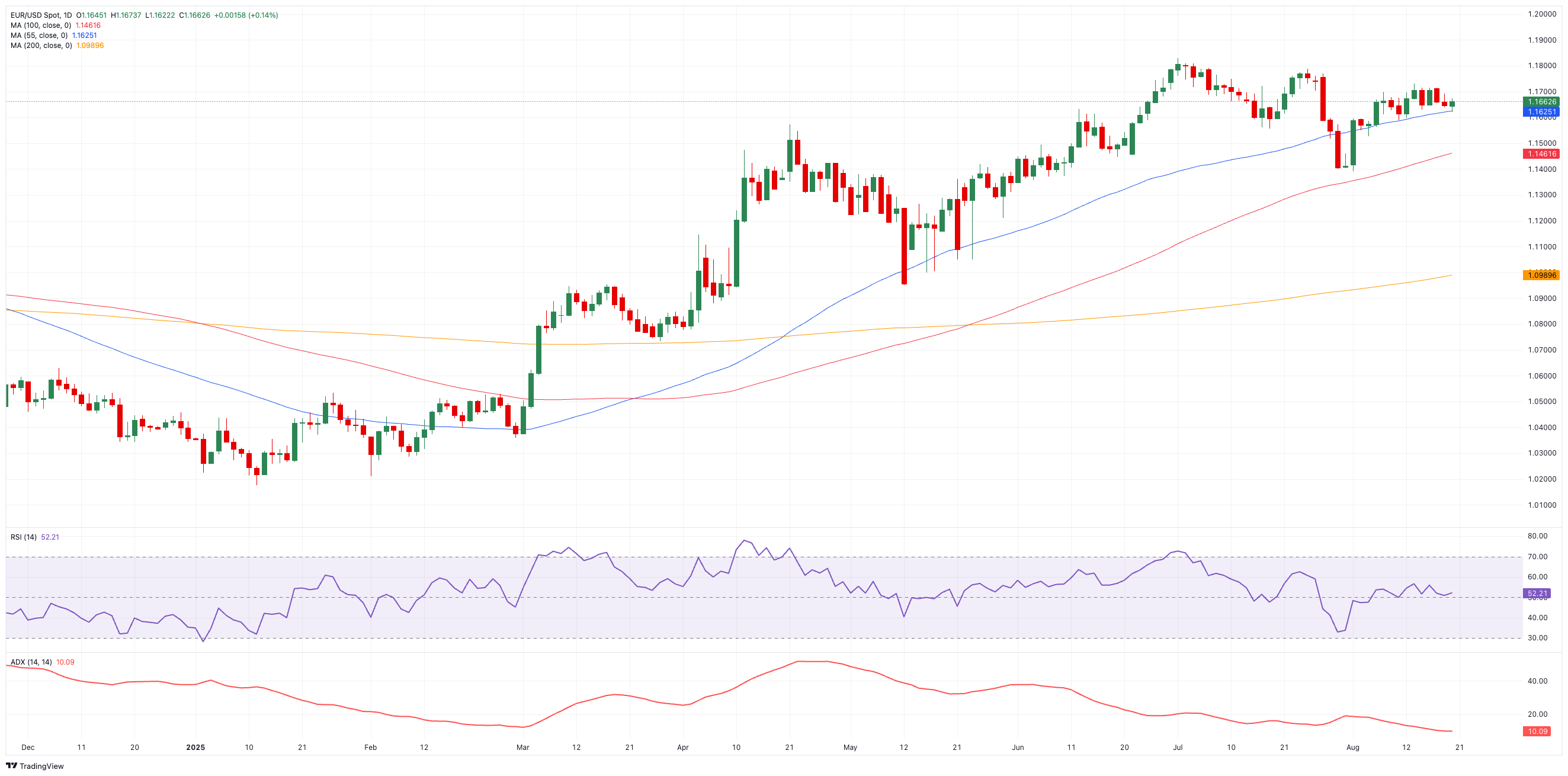
- EUR/USD managed to set aside some of its recent losses and revisited 1.1670.
- The US Dollar faced some tepid selling pressure ahead of PMIs and Jackson Hole.
- President Trump called for Fed Governor Lisa Cook to resign.
The Euro (EUR) seems to have finally found some momentum on Wednesday, motivating EUR/USD to stage a mild comeback and revisit the 1.1670 region.
The pair’s daily uptick came as the US Dollar (USD) held an equally tepid offered bias, with traders weighing another attack by President Trump on the Federal Reserve (Fed), this time urging Governor Lisa Cook to resign.
In the meantime, there was no relevant news from the geopolitical backdrop, while markets’ attention shifted to the release of flash PMIs on Thursday and Chief Powell’s speech at Jackson Hole on Friday.
Trade truce cools tempers, not worries
Markets drew some relief from a temporary pause in global trade tensions. Washington and Beijing agreed on a 90-day extension to their deal, just hours before new tariffs were due. President Trump signed an executive order delaying hikes until November 10, with Beijing pledging reciprocal steps. Still, existing tariffs remain hefty: 30% on Chinese exports to the US and 10% on US shipments heading the other way.
In parallel, the US and EU struck their own deal weeks ago. Brussels trimmed most tariffs on American goods to 15% from a threatened 30%, while promising $750 billion in US energy purchases, extra defence orders, and over $600 billion in American investments. Reaction in Europe was gloomy: German Chancellor Friedrich Merz warned the deal could squeeze manufacturing, while French President Emmanuel Macron branded it a “dark day” for Europe.
Central banks: Waiting on data
The Fed left rates unchanged at its last meeting, with Jerome Powell striking a careful balance between steady hands and dovish leanings from Governors Christopher Waller and Michelle Bowman.
Still around the Fed, the Minutes of the latest gathering noted that the two officials who disagreed with the Fed’s decision to keep interest rates the same last month (Christopher Waller and Michelle Bowman) did not have any other policymakers join them in calling for lower rates at that meeting. According to the Minutes, Fed members thought that the consequences of increased tariffs were becoming clearer in the cost of specific items, but they were still not sure what the overall effect on the economy and inflation would be. Looking forward, the participants said they could have to make tough choices if inflation stayed high and the employment environment became worse.
Over in Frankfurt, European Central Bank (ECB) President Christine Lagarde described eurozone growth as “solid, if a little better.” Even so, markets now expect the ECB’s first rate cut to be pushed back until spring 2026.
Speculators cut back
Speculative appetite for the Euro has cooled. Commodity Futures Trading Commission (CFTC) report through August 12 showed net long positions dropping to a six-week low at about 115.4K contracts, while commercial traders lifted net shorts above 167K, the highest in two weeks. In addition, open interest also bounced back to roughly 825K after two weeks of decline.
Charts: Resistance close, momentum fading
Upside levels are capped by the weekly high at 1.1788 (July 24), the YTD ceiling at 1.1830 (July 1), and the September 2021 peak at 1.1909 (September 3), just below the psychological 1.2000.
On the downside, provisional support is seen at the 100-day SMA at 1.1468, then the August base at 1.1391 (August 1) and the weekly floor at 1.1210 (May 29).
Indicators don’t inspire confidence: The Relative Strength Index (RSI) remains around 52, hinting at potential further gains, while the Average Directional Index (ADX) near 11 points to a weak trend.
EUR/USD daily chart

Near-term outlook suggests further consolidation
For now, EUR/USD looks boxed in. A breakout may hinge on the Fed’s tone or a sharper turn in trade tensions. Until then, the Dollar keeps the upper hand when it comes to ruling the price action.
ECB FAQs
The European Central Bank (ECB) in Frankfurt, Germany, is the reserve bank for the Eurozone. The ECB sets interest rates and manages monetary policy for the region. The ECB primary mandate is to maintain price stability, which means keeping inflation at around 2%. Its primary tool for achieving this is by raising or lowering interest rates. Relatively high interest rates will usually result in a stronger Euro and vice versa. The ECB Governing Council makes monetary policy decisions at meetings held eight times a year. Decisions are made by heads of the Eurozone national banks and six permanent members, including the President of the ECB, Christine Lagarde.
In extreme situations, the European Central Bank can enact a policy tool called Quantitative Easing. QE is the process by which the ECB prints Euros and uses them to buy assets – usually government or corporate bonds – from banks and other financial institutions. QE usually results in a weaker Euro. QE is a last resort when simply lowering interest rates is unlikely to achieve the objective of price stability. The ECB used it during the Great Financial Crisis in 2009-11, in 2015 when inflation remained stubbornly low, as well as during the covid pandemic.
Quantitative tightening (QT) is the reverse of QE. It is undertaken after QE when an economic recovery is underway and inflation starts rising. Whilst in QE the European Central Bank (ECB) purchases government and corporate bonds from financial institutions to provide them with liquidity, in QT the ECB stops buying more bonds, and stops reinvesting the principal maturing on the bonds it already holds. It is usually positive (or bullish) for the Euro.
Information on these pages contains forward-looking statements that involve risks and uncertainties. Markets and instruments profiled on this page are for informational purposes only and should not in any way come across as a recommendation to buy or sell in these assets. You should do your own thorough research before making any investment decisions. FXStreet does not in any way guarantee that this information is free from mistakes, errors, or material misstatements. It also does not guarantee that this information is of a timely nature. Investing in Open Markets involves a great deal of risk, including the loss of all or a portion of your investment, as well as emotional distress. All risks, losses and costs associated with investing, including total loss of principal, are your responsibility. The views and opinions expressed in this article are those of the authors and do not necessarily reflect the official policy or position of FXStreet nor its advertisers. The author will not be held responsible for information that is found at the end of links posted on this page.
If not otherwise explicitly mentioned in the body of the article, at the time of writing, the author has no position in any stock mentioned in this article and no business relationship with any company mentioned. The author has not received compensation for writing this article, other than from FXStreet.
FXStreet and the author do not provide personalized recommendations. The author makes no representations as to the accuracy, completeness, or suitability of this information. FXStreet and the author will not be liable for any errors, omissions or any losses, injuries or damages arising from this information and its display or use. Errors and omissions excepted.
The author and FXStreet are not registered investment advisors and nothing in this article is intended to be investment advice.




